 |
| Unlikely superhero and saviour of the human race, the humble nettle. Genuine good guy. |
Its true, nettles solve many world problems and mushroom compost is a star with flowers. So I'm lounging around (not gardening), as usual, its gale season and the latest copy of HDC news (horticultural development council) landed on my overly composty desk that I habitually share with el garden guru at one of my jobs. In my new role I get to read alot of the latest hot hort news (and there is lots, let me tell you) and fill him in on the details. I think they call this delegation, he's a very busy guru. He doesn't opt for my soft approach to gardening, he's out on the coal face daily, so I tackle the hort tabloids for juicy gossip.....(yes seriously, I'm this focussed on staying indoors).
So what's new in flower research you might well ask.... well the hottest news is Ash and the spread of the new chara pathogen.......
Ash tree (Fraxinus) trade restrictions have been imposed in the UK for imports and movements domestically due to chalara dieback.
The new form of this fungus pathogen, formerly a lie about leaf litter decaying sort, is only known in europe so far. And its an ugly little so and so throughout its life cycle.
Like many of those pesky fungal types its got a complicated life cycle and disguises itself as a fungi type of thing lurking on a branch. Not easily noticed I suspect.
And this is what it looks like on the plant. Pretty nasty eh?
Whilst some species are showing resistance in German trials (the meliodes group and the ornus group) and substitutions might be made in amenity platings (Fraxinus americana, F. pennsylvanica) others are not so suitable. However no common ash (F. excelsior) look like being resistant with golden and pendulous forms especially susceptible. Sad news indeed. (HDC news November, pg 9) so if thinking ash, potentially we're looking at getting use to different species in our amenity plantings........
And so to strawberries........
 |
| Chara - stem leisons, A new lethal disease of ash trees (Fraxinus excelsior) was detected in 2008 in Switzerland after having caused significant damage previously in other countries. Symptoms are necrotic bark lesions (Fig. 1, 2) and wilting (Fig. 3). Source |
| The fungus forms slow growing cultures (Fig. 4, reverse Fig. 5) and distinct conidiophores on which sticky, colorless, ellipsoid conidia (spores) are produced (Fig. 6). Photos from this article |
 |
| Later on, next stafe of life, the fungus is detected on branches, formed during summer on ash petioles in the litter (Fig. 7, 8; up to 3 mm). The fungal spores these produce (Fig. 9) are transmitted by wind and explains the rapid spread of the disease. Source. |
 |
| Ash tree infected with charala. |
And so to strawberries........
Did you know that the most interesting June bearing strawberries from UK and overseas are being trialled over the next year and a half and compared to 'Elsanta'. No matter if you love or hate the supermarkets favourite, new varieties are always interesting although others argue the heritage varieties have superior flavour. I'll be getting my scones ready to help them test the best of them...(pg13)
And so again to change track to mushroom compost, column stocks (one of my favourite cut flowers in the garden) grown in soil enhanced with mushroom compost led to earlier blooms, with heavier flowers than other treatments. Bark was also used with great results. Looking after your soil structure is considered perhaps more important for disease control than previously thought. But us gardeners know that don't we? ;) (pg17) [Janet, buy some stocks for all that spent mushroom compost you have!]
Leaving diseased (blight) cucumber leaves or fruits in a tunnel/greenhouse leads to trouble. Sad fact of life is that they love a clean hoose. Did you know that one quarter of an infected fruit can generate a conservative 300 million or so fungal spores? So if growing these canny beasts, make sure you clear up any dead leaves or fruits quickly. De-leafing (which does sound quite rude) is also important to reduce humidity around plants, seems to be a key to managing these diseases too and also mosaic viruses. Sound stuff there from the Cucumber gurus. (pg 21) we'll be practising that increased crop management in our tunnels last year.
And, finally nettles (Urtica) save the world, yes really, a step at a time. Now for long enough us less than pristine gardeners have told folks that a weed free plot is quite unnatural, not that we are lazy, honest. Well nettles it appears significantly reduce problem insects like pear suckers and many others by offering a habitat to build up beneficial bugs to predate those pesky suckers. Reducing the need to spray crops and increasing crop yields. Just goes to show you, an evil stinging plant like nettles are, they do have their uses! (pg 24) so if you've got them, learn to love them, after all an overly tidy patch isn't necessarily good for wildlife. It's official a bit of messiness does you good.
So there you have it, a wee bit of hort research update to help us all out, off with my tea in hand to blether to the guru and fill him in on this months juicy bits.....
You see aside the blethers and the hoonds and the cooking and the rambles and walks, I really am a bit plant obsessed. More walking soon.........
PS at £7.50 a month, I'd find the HDC news at the library if you can or read the highlights online, its a good read but a wee bit pricey. Those plant scientists do need to eat however!





Will have to get my hands on some of that ex-mushroom stuff for next year - thanks for the tip! My sister swears by it for her veggies too.
ReplyDeleteI've never used it but by the looks of it - excellent stuff - well deserving the black gold. Nice to see you on here, love your blog!
DeleteIf there is anything I remember from my childhood it's stinging nettles. We had an abundance of them where our playhouse/shed was at what we called the bottom of the garden, but was just an area left to run riot.
ReplyDeleteAlong with stinging nettles the remedy when stung was a dock leaf.
Every spring nettle tonic was made.
Interesting about their help in the garden against pests.
Christy
lil Bit Brit
Now I loathe nettles at anything but a distance, I swear they seek me out and bite me. I remember filling my first veggie plot with topsoil littered with yellow roots thinking oh how pretty I wonder what they are - answer nettles. Argh. But for the good of the insects, we need em!
DeleteWhat did they use the nettle tonic for? Interesting.
My philosophy has always been that every plant and all creatures have their particular place and purposes in the world. We don't really know how we are all interdependent on each other, and if we wily-nilly get rid of certain things, we may be starting a cascading effect we had not anticipated. I am happy to say that weeds find a comfortable home in my garden, or at least parts of it. I am sorry to hear about the ash fungus, and I wonder how that particular disease came about.
ReplyDeleteLive and let live is my philosophy aside slugs, I'm afraid.
DeleteI'm glad your philosophy works for you too!
The ash fungus well theren't not sure if this new strain has been introduced or became a pathogen by mutation hopefully those clever white coat wearing mycologists and microbiologists (of which my chum is one) will figure it out soon - a countryside in the UK without Ash is a strange thought.
Second only to Bracken in being the most prolific plant on the Bonsai Mountain, war has been declared on the nettle.
ReplyDeleteAnd gorse.
The plants are winning.
Tony the plants will always overcome. Not much bracken here but we have gorse.
DeleteEnjoy the war, I'm sure you'll hold your own, although I'd not be betting on anyone but the nettles, sorry!
Fay, so very interesting all this stuff aboot joby nikles and the likes, have you ever tried to spell something which is probably only known to a very small part of the population? Well anyway I am now putting you in the same scientific folder along with b-a-g.
ReplyDeleteJoby nikles (?nettles?) never heard that one before! I like the fact that I can spell (badly) botanical latin and know that potentially no one will now if I did it wrong, or said it wrong, its a pretty helpful (if dead) language! Very universal.
DeleteOh I get a scientific folder, oh good, that can go with my dissecting kit and my lab coat (much loved) sometimes the secret plant scientist in me emerges, generally when its cold and the body is less occupied with digging.
I must check out b-a-g too :)
I like having other people do my research for me, thank you! I'd like some nettles in my wild corner by the enormous tree stump, so while most people are battling to get rid of them I will be sowing them!!!
ReplyDeleteI like the HDC do the research for us eh? Its interesting reading what's hot and not at the moment, my old supervisor now puts this on my desk for me, he knows how much I miss reading up the juicy gossip! Enjoy the nettles, the soup and the wildlife that will no doubt follow.
DeleteNettles love ashes from wood and coalfires, a little at a time. At my childhood home nettles were growing in abundance around the ashesheap. Alehoof (with the small blue flowers) also helps when crushed and rubbed over where the stingingnettle bit you. Maybe it is just a Dutch remedy?
ReplyDeleteYou're brave collecting mushrooms and eating them! I guess if you are with other people who know what they are looking for it might make it better. spore syringe
ReplyDeleteGood Article, also checkout http://www.mushroomsource.ca for all supplies that you need to grow mushrooms
ReplyDelete